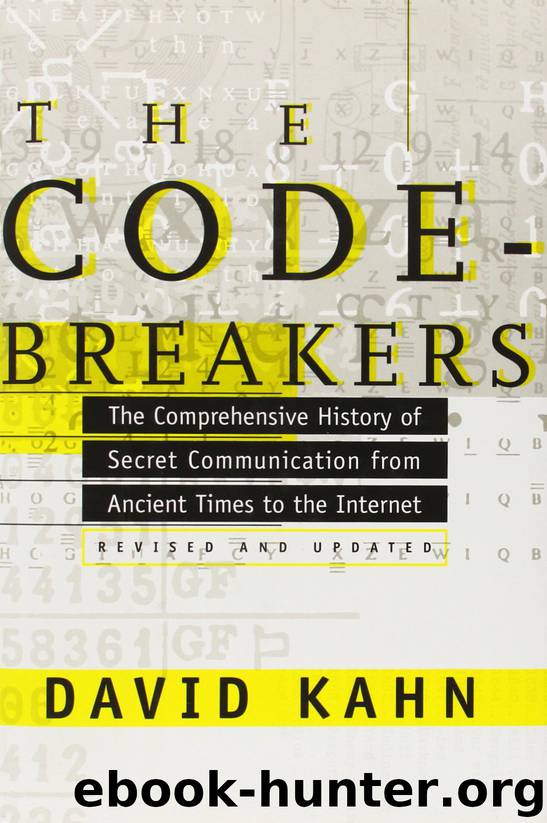The Codebreakers: The Comprehensive History of Secret Communication from Ancient Times to the Internet by Kahn David

Author:Kahn, David [Kahn, David]
Language: eng
Format: epub, mobi
Publisher: Scribner
Published: 2015-02-21T16:00:00+00:00
18
*
ALTHOUGH SECRET WRITING appears in Russia in the simple letter-substitutions of 12th- and 13th-century manuscripts, akin to those of medieval France and Germany, political cryptography seems to have first come to the country under the Westernizing influence of Peter the Great.
The most direct evidence outside the nation’s archives lies in the records of England’s Decyphering Branch, whose first Russian solution is dated 1719—the 37th year of Peter’s reign. This accords well with what one might expect. Peter was fascinated by technical arts of all kinds; he not only studied them but picked up their tools and worked at them. He perhaps heard about codes and ciphers during his visits to Holland and England in 1697-98 and Paris in 1717. It was a time when official nomenclators were formally employed by the emergent nations of Europe—and when cryptanalysts were paid to solve them. If he himself did not import cryptography to Russia, the seeds might have been planted by the foreigners that Peter imported for the governmental reforms that began in 1712. The new structure was modeled on Sweden’s, and perhaps included a cipher office, for by that time Sweden had had more than a century and a half of cryptographic experience—employing, for example, a one-part code of almost 4,000 groups in 1700. Secret writing thus might well have been among the new and useful practices that Peter adopted in transforming Russia from the semibarbarism of Ivan the Terrible to a modern state.
The first ciphers used by Peter’s ambassadors in London were as primitive as his country then was, and had no more security than first ciphers usually possess: they were monalphabetic substitutions. The plaintext was replaced with secret symbols hardly less bizarre to the insular English eye than the original Cyrillic letters themselves. Such systems served at least until 1728. In the reign of Peter’s strong-willed daughter, Elizabeth, Russian cryptography suddenly blossomed forth with all the maturity of Europe’s best. In 1754, the Russian ambassadors to England employed a two-part nomenclator of 3,500 elements, including homophones. It was in French, which was then not only the language of diplomacy but also the tongue cultivated in most of the courts of Europe, nowhere more slavishly than in Russia’s. (Sweden, too, was using French-language codes.) Other, smaller two-part nomenclators followed at frequent intervals: one of 900 elements appeared in 1755, and still another of 1,000 in 1761.
Download
The Codebreakers: The Comprehensive History of Secret Communication from Ancient Times to the Internet by Kahn David.mobi
This site does not store any files on its server. We only index and link to content provided by other sites. Please contact the content providers to delete copyright contents if any and email us, we'll remove relevant links or contents immediately.
Cecilia; Or, Memoirs of an Heiress — Volume 1 by Fanny Burney(31332)
Cecilia; Or, Memoirs of an Heiress — Volume 3 by Fanny Burney(30934)
Cecilia; Or, Memoirs of an Heiress — Volume 2 by Fanny Burney(30889)
The Lost Art of Listening by Michael P. Nichols(6472)
We Need to Talk by Celeste Headlee(4868)
Asking the Right Questions: A Guide to Critical Thinking by M. Neil Browne & Stuart M. Keeley(4574)
On Writing A Memoir of the Craft by Stephen King(4213)
Dialogue by Robert McKee(3582)
I Have Something to Say: Mastering the Art of Public Speaking in an Age of Disconnection by John Bowe(3516)
Pre-Suasion: A Revolutionary Way to Influence and Persuade by Robert Cialdini(3413)
Elements of Style 2017 by Richard De A'Morelli(2943)
The Book of Human Emotions by Tiffany Watt Smith(2770)
Good Humor, Bad Taste: A Sociology of the Joke by Kuipers Giselinde(2557)
Name Book, The: Over 10,000 Names--Their Meanings, Origins, and Spiritual Significance by Astoria Dorothy(2490)
Fluent Forever: How to Learn Any Language Fast and Never Forget It by Gabriel Wyner(2445)
The Grammaring Guide to English Grammar with Exercises by Péter Simon(2393)
Why I Write by George Orwell(2359)
The Art Of Deception by Kevin Mitnick(2297)
Don't Sleep, There Are Snakes by Daniel L. Everett(2216)
